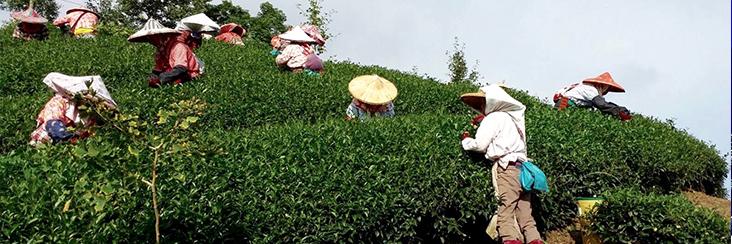
A Fine Fall Harvest Of Shan Lin Xi High Mountain Tea

The images above and below are snapshots our friend Mr. Chen took while he weighed the harvested leaves from each tea picker as they emptied and refilled their baskets with tender new leaf. This is a moderately sized tea farm by high mountain tea production standards, and the amount of leaves harvested on a given day is limited by the capacity of a locally owned factory in a residential community at the foot of the mountain. These are significant factors that determine both the quality of tea and the sustainability of production, which is why we've chosen this source.

We've been procuring High Mountain Tea from this region for over 20 years. And it has only been in recent years that we've discovered quality batches of tea being produced from both summer and fall harvests — and at a significantly lower price than spring and winter harvests. While readily admitting that we, along with the majority of avid tea lovers in Taiwan, were perhaps snobbishly prejudiced toward spring and winter harvests — wanting only what has been promoted to be the best choices — we also happily acknowledge that there has been recent progress in the production of High Mountain Tea.

A significant, yet relatively minimal number High Mountain Tea producers in this region are purposely allowing their leaves to oxidize more than the standard of High Mountain Tea production method. This is evidently a positive effect of the demand for more oxidized leaves to be used for the Lugu Farmers' Association Dong Ding Oolong Tea competition, which requires post production roasting of leaves that are adequately oxidized. This is the pioneering and most prestigious Oolong Tea competition in the world, where roughly 85,000 kg of tea leaves are submitted semi-annually. And this competition's standard has resulted in many other competitions following suit in determining their own regional competition standard.
Not only has the recognition of slightly more oxidized leaves grown at higher elevations been acknowledged by individual tea producers as superior quality. Other regional competitions have been influenced by the recognition that their competition standard is a more valuable product if processed in this fashion rather than as a minimally oxidized High Mountain Tea. The inadvertent and secondary outcome is that summer and fall harvests are the most obvious improvements of these trends, even though these harvests are not used for competitions. In our experience, the tea makers we've befriended and observed have begun to seasonally customize their processing methods. And within this, there are daily adjustments in processing for a particular demand of a given quality of tea. We see this as a very progressive practice that acknowledges the value of differentiation in producing a sustainable resource of specialty tea.

In addition to this, we also acknowledge that the seasonal differences between harvests has become less consistent in recent years due to less predictable seasonal weather conditions, which were seemingly more predictable in past decades. So we are compelled to reconsider the relative seasonal value of harvests throughout the year, and enthusiastically offer the option of the more economical alternative to the same produce, different season — which we find very satisfying!

